Some people experience a kind of shooting pain most commonly on the leg. A pain that somehow radiates to the lower back. Ever heard of Sciatica? Sciatica refers to pain that radiates along the path of the sciatic nerve, which branches from your lower back through your hips and buttocks and down each leg. Typically, sciatica affects only one side of your body.
What if I tell you that you don’t have to put up with enduring those pain and that medication and surgery are not the only way to treat Sciatica? Yes. Physical therapy is one of the most recommended remedies for Sciatica and here’s how:
Physical therapy and exercise are typically first-line treatments for relieving, treating, and preventing sciatica symptoms that include, lower back, hip, and/or leg pain, numbness, tingling, and/or weakness in the buttock, thigh, leg, and/or foot. There may be underlying medical conditions that trigger sciatica such as herniated or degenerated disc, or nerve root compression in the lumbar spine.
There will always be a physical examination and your doctor may check your muscle strength and reflexes. If there’s a severe case of Sciatica, doctors would usually run tests such as X-rays, MRI, CT Scan, and EMG (Electromyography)
After a thorough assessment, your doctor or a physical therapist can design a rehabilitation program to help you prevent future injuries. This typically includes exercises to correct your posture, strengthen the muscles supporting your back, and improve your flexibility.
Here’s How Physical Therapy Can Help With Sciatica:
- Pigeon Pose (Reclining)- This is a great pose for opening the hips and stretching the back and used in yoga.
- Pigeon Pose (Sitting)- If you’re able to easily do the pigeon pose while reclining, it’s time to move to the sitting version.
- Knees To Opposite Shoulder – This stretch offers sciatica pain relief, by stretching and loosening both the piriformis and gluteal muscles.
- Sitting Spinal Stretch – This stretch helps relieve back pain and decompress the spine, and is quite simple.
- Standing Hamstring Stretch – This stretch helps relieve hamstring tightness caused by sciatica.
Many would be researching these poses online but a friendly reminder is needed that you have to do this with a therapist since each pose targets a certain muscle that would greatly affect the result of your therapy.
For most people, sciatica responds to self-care measures. Although resting for a day or so may provide some relief, prolonged inactivity will make your signs and symptoms worse.
Other self-care treatments that might help include:
Cold packs. Initially, you might get relief from a cold pack placed on the painful area for up to 20 minutes several times a day. Use an ice pack or a package of frozen peas wrapped in a clean towel.
- Hot packs. After two to three days, apply heat to the areas that hurt. Use hot packs, a heat lamp, or a heating pad on the lowest setting. If you continue to have pain, try alternating warm and cold packs.
- Stretching. Stretching exercises for your low back can help you feel better and might help relieve nerve root compression. Avoid jerking, bouncing or twisting during the stretch, and try to hold the stretch for at least 30 seconds.
- Over-the-counter medications. Pain relievers such as ibuprofen (Advil, Motrin IB, others) and naproxen sodium (Aleve) are sometimes helpful for sciatica. Always consult your physician.
Many are still in doubt if they will seek Physical therapy. But many patients who have gone through it recommend it instead of surgery. Doctors would also suggest physical therapy first before going under the knife since it is much safer than surgery.
Each therapist will also have different stretching exercises for you to do but these are the common ones. It would still depend on your individualized plan and limitations they might impose on your treatment.
Fight Back Against Sciatica With These Stretches!
Surgery isn’t the only option for sciatica pain. These stretches are great for physical therapy for sciatica and can help you find the relief you need from the discomfort of minor-to-moderate sciatica.
If you want to know more about how physical therapy can help with sciatica, then talk to one of our doctors. Tribeca Physical Therapy is officially reopened for in-person physical therapy sessions and continues to offer Telehealth PT or Virtual PT. Call us at 2124068080 or message us and book your first session free.



